Page 54 of 474
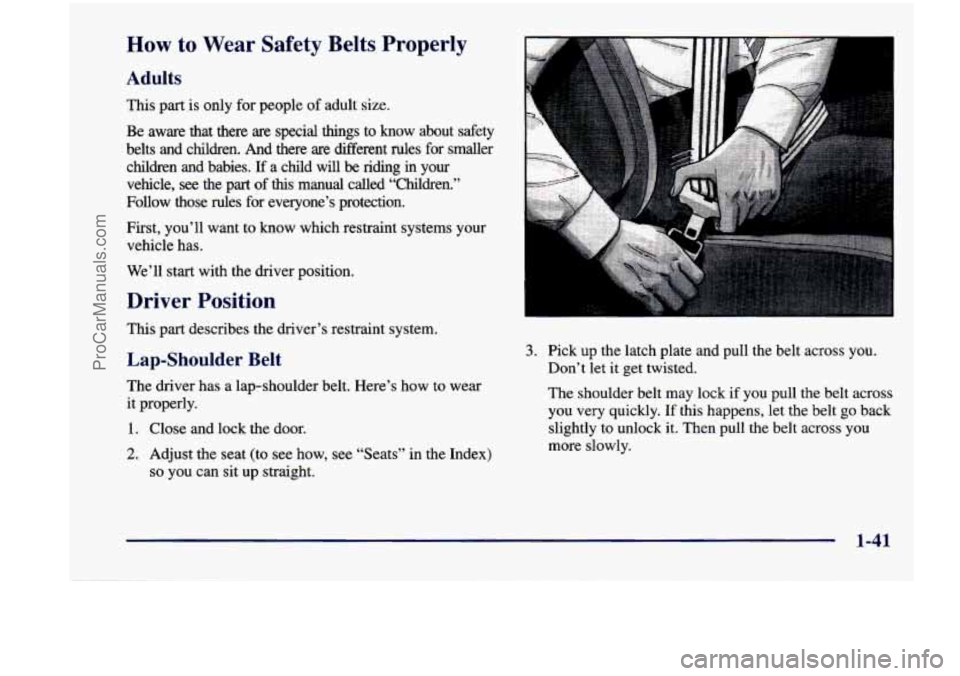
How to Wear Safety Belts Properly
Adults
This part is only for people of adult size.
Be aware that there are special things to know about safety
belts
and children. And there are different rules for smaller
children and babies.
If a child will be riding in your
vehicle, see the part of
hs manual called “Children.”
Follow those rules for everyone’s protection.
First, you’ll want to know which restraint systems your
vehicle has.
We’ll start with the driver position.
Driver Position
This part describes the driver’s restraint system.
Lap-Shoulder Belt
The driver has a lap-shoulder belt. Here’s how to wear
it properly.
1. Close and lock the door.
2. Adjust the seat (to see how, see “Seats” in the Index)
so you can sit up straight.
3. Pick up the latch plate and pull the belt across you.
Don’t let it get twisted.
The shoulder belt
may lock if you pull the belt across
you very quickly. If this happens, let the belt go back
slightly to unlock it. Then pull the belt across you
more slowly.
1-41
ProCarManuals.com
Page 55 of 474
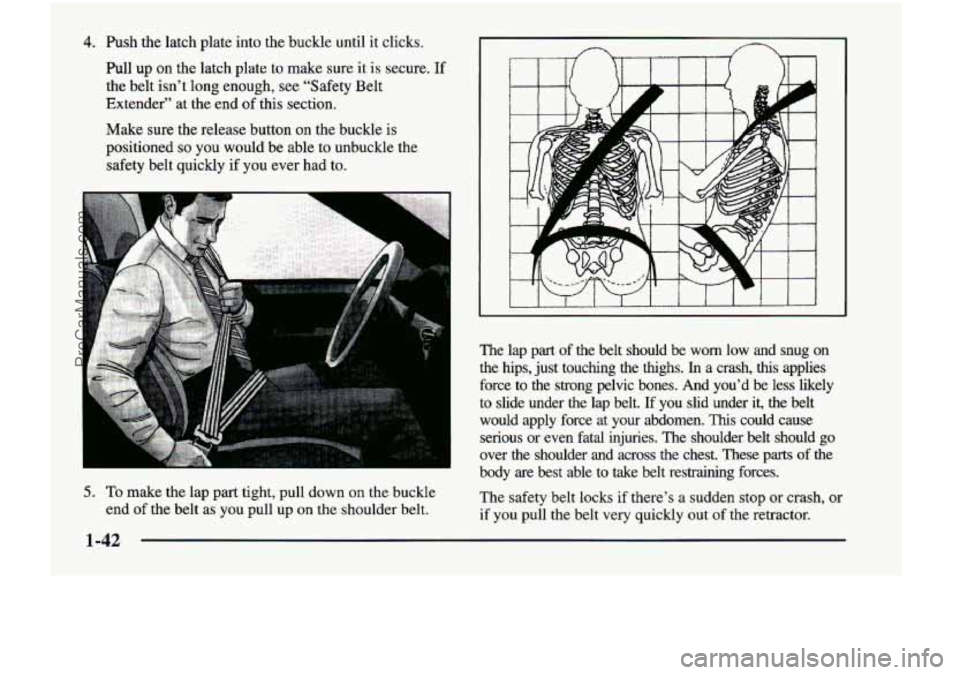
4. Push the latch plate into the buckle until it clicks.
Pull
up on the latch plate to make sure it is secure. If
the belt isn’t long enough, see “Safety Belt
Extender” at the end
of this section.
Make sure the release button on the buckle is
positioned
so you would be able to unbuckle the
safety belt quickly if you ever had to.
5. To make the lap part tight, pull down on the buckle
end
of the belt as you pull up on the shoulder belt. The lap
part of the belt should be worn low and snug on
the hips, just touching the thighs.
In a crash, this applies
force to the strong pelvic bones. And you’d be less likely \
to slide under the lap belt. If you slid under it, the belt \
would apply force at your abdomen.
This could cause
serious or even fatal injuries. The shoulder belt should go
over the shoulder and across the chest. These
parts of the
body
are best able to take belt restraining forces.
The safety belt locks if there’s a sudden stop or crash, or
if you pull the belt very quickly out of the retractor.
1-42
ProCarManuals.com
Page 56 of 474
Shoulder Belt Height Adjuster To move it down, push down on the button and move
Before you begin to drive, move the shoulder belt the
height adjuster to the desired position. You can move
adjuster to the height that is right for you. the
adjuster up just by pushing up on the shoulder belt
guide. After you
move the adjuster to where you want it,
try to move it down without pushing the button down to
\-I make sure it has locked into position.
Adjust the height
so that the shoulder portion of
the belt is centered on your shoulder. The belt should
be away from your face and neck, but not falling
off
your shoulder.
1-43
ProCarManuals.com
Page 63 of 474
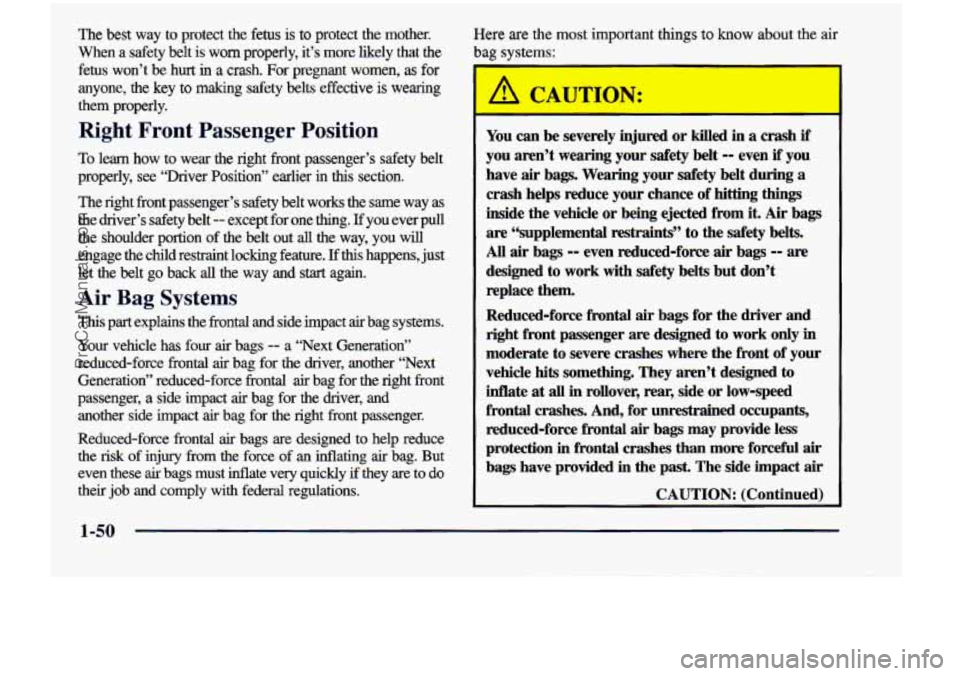
The best way to protect the fetus is to protect the mother.
When a safety belt is worn properly, it’s more likely that the
fetus won’t be hurt
in a crash. For pregnant women, as for
anyone,
the key to making safety belts effective is wearing
them properly.
Right Front Passenger Position
To learn how to wear the right front passenger’s safety belt
properly, see “Driver Position” earlier
in this section.
The right front passenger’s safety belt works the same way \
as
the driver’s safety belt
-- except for one thing. If you ever pull
the shoulder portion of the belt out all the way, you will
engage the
child restraint locking feature. If this happens, just
let the belt go back all the way and start again.
Air Bag Systems
This part explains the frontal and side impact air bag systems.
Your vehicle has four air bags -- a “Next Generation”
reduced-force frontal
air bag for the driver, another “Next
Generation” reduced-force
frontal air bag for the right front
passenger, a side impact
air bag for the driver, and
another side impact
air bag for the right front passenger.
Reduced-force frontal
air bags are designed to help reduce
the
risk of injury from the force of an inflating air bag. But
even these
air bags must inflate very quickly if they are to do
their job and comply with federal regulations. Here
are the most important things to know
about the -ir
bag systems:
CAUTION:
You can be severely injd or killed in a crash if
you aren’t wearing your safety belt -- even if you
have
air bags. Wearing your safety belt during a
crash helps reduce your chance of hitting things
inside the vehicle or being ejected from it.
Air bags
are “supplemental restraints”
to the safety belts.
All air bags -- even reduced-force air bags -- are
designed to work with safety belts but don’t
replace them.
Reduced-force frontal
air bags for the driver and
right front passenger are designed to work only
in
moderate to severe crashes where the front of your
vehicle
hits something. They aren’t designed to
inflate
at all in rollover, rem, side or low-speed
frontal crashes. And, for unrestrained occupants,
reduced-force frontal
air bags may provide less
protection in frontal crashes than more forceful
air
bags have provided in the past. The side impact air
CAUTION: (Continued)
1-50
ProCarManuals.com
Page 67 of 474
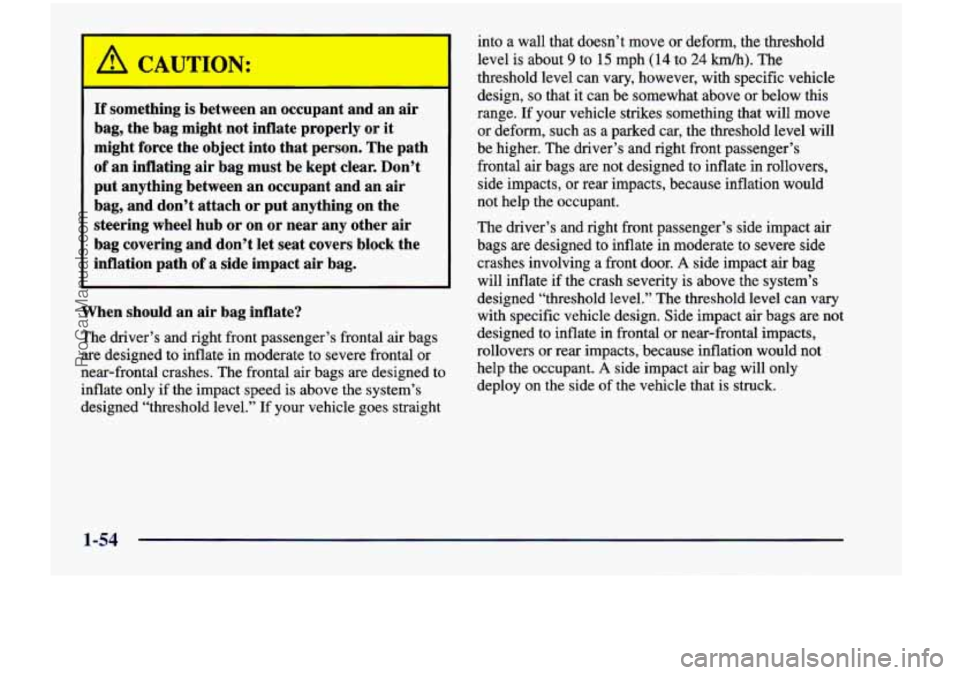
A CAUTION:
If something is between an occupant and an air
bag, the bag might not inflate properly or
it
might force the object into that person. The path
of an inflating air bag must be kept clear. Don’t
put anything between an occupant and an air
bag, and don’t attach or put anything on the
steering wheel hub or on or near any other air
bag covering and don’t let seat covers block the
inflation path
of a side impact air bag.
When
should an air bag inflate?
The driver’s and right front passenger’s frontal air bags
are designed to inflate in moderate to severe frontal or
near-frontal crashes. The frontal air bags are designed to
inflate only
if the impact speed is above the system’s
designed “threshold level.” If your vehicle goes straight into a wall that doesn’t move
or deform, the threshold
level is about
9 to 15 mph (14 to 24 km/h). The
threshold level can vary, however, with specific vehicle
design,
so that it can be somewhat above or below this
range.
If your vehicle strikes something that will move
or deform, such as a parked car, the threshold level will
be higher. The driver’s and right front passenger’s
frontal air bags are not designed to inflate in rollovers,
side impacts, or rear impacts, because inflation would
not help the occupant.
The driver’s and right front passenger’s side impact air
bags are designed to inflate in moderate
to severe side
crashes involving a front door.
A side impact air bag
will inflate if the crash severity is above the system’s
designed “threshold level.” The threshold level can
vary
with specific vehicle design. Side impact air bags are not
designed to inflate in frontal or near-frontal impacts,
rollovers or rear impacts, because inflation would not
help the occupant.
A side impact air bag will only
deploy on the side
of the vehicle that is struck.
1-54
ProCarManuals.com
Page 72 of 474
4 r .. .
Lap-Shoulder Belt
The positions next to the windows have lap-shoulder
belts. Here’s how to wear one properly. 1. Pick up the latch plate and pull the belt across you.
Don’t let it get twisted.
The shoulder belt may lock if you pull the belt across
you very quickly. If this happens, let the belt go back
slightly to unlock it. Then pull the belt across you
more slowly.
1-59
ProCarManuals.com
Page 73 of 474
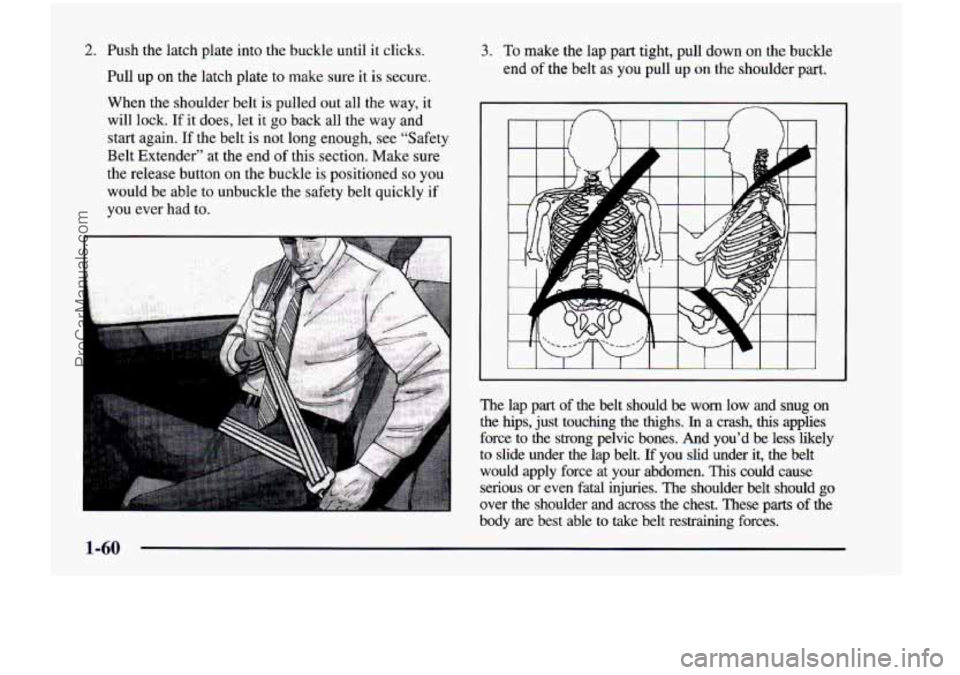
2. Push the latch plate into the buckle until it clicks.
Pull up
on the latch plate to make sure it is secure.
When the shoulder belt
is pulled out all the way, it
will lock. If it does, let it go back all the way and
start again. If the belt
is not long enough, see “Safety
Belt Extender” at the end
of this section. Make sure
the release button on the buckle is positioned
so you
would be able to unbuckle the safety belt quickly
if
you ever had to.
3. To make the lap part tight, pull down on the buckle
end
of the belt as you pull up on the shoulder part.
n n
I I I I
The lap part of the belt should be worn low and snug on
the hips, just touching the thighs. In a crash, this applies
force to the strong pelvic bones. And you’d be less likely \
to slide under the lap belt. If you slid under it, the belt \
would apply force at your abdomen.
This could cause
serious or even fatal injuries. The shoulder belt should go
over the shoulder and across the chest. These
parts of the
body are best able to take belt restraining forces.
ProCarManuals.com
Page 74 of 474
The safety belt locks if there’s a sudden stop or a crash,
or if you pull the belt very quickly out of the retractor.
I
A CAUTION:
I
You can be seriously hurt if your shoulder belt is
too loose. In a crash, you would move forward
too much, which could increase injury. The
shoulder belt should fit against your body.
To unlatch the belt, just push the button on the buckle.
1-61
ProCarManuals.com